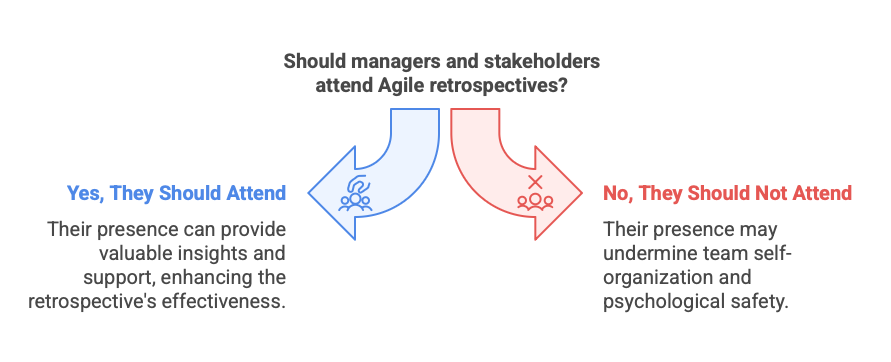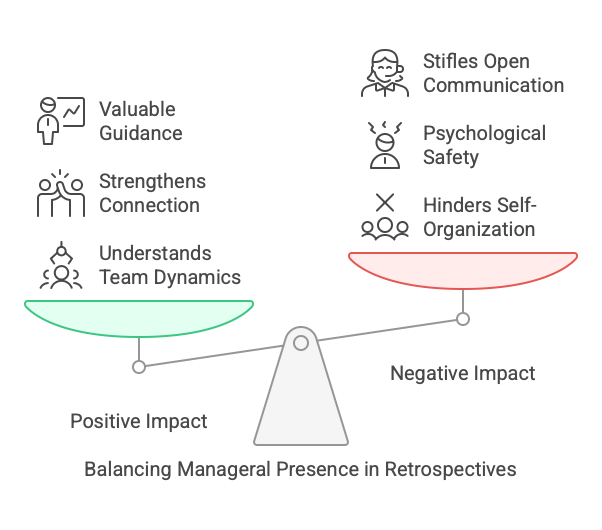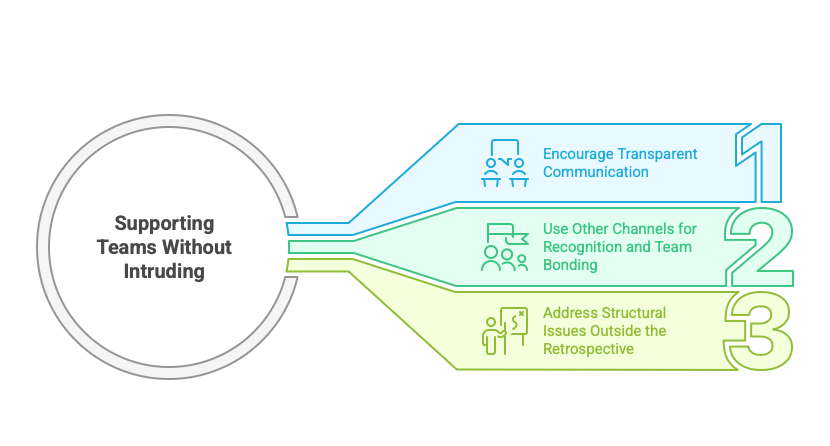📌 TL;DR:
- Mandatory attendees: Development Team + Scrum Master
- Product Owner: Optional, depending on team dynamics
- Managers: Only if explicitly invited by the team
- Stakeholders: No, they should participate in Sprint Reviews instead
Agile retrospectives are a vital practice in continuous improvement, but a recurring question in many Agile teams is: should managers and stakeholders be present at retrospectives?

This question is more nuanced than a simple yes or no.
While the Scrum Guide provides a clear definition of who the core participants are, other factors play a huge role in determining whether a manager’s presence will be beneficial or detrimental.
This article explores:
- Who must attend retrospectives
- Whether a manager should be invited
- If stakeholders have a role
- Special cases where inviting external participants might make sense
Who Should Attend a Retrospective?
The Core Participants

According to the Scrum Guide (2020 edition):
“The Scrum Team consists of one Scrum Master, one Product Owner, and Developers. Within a Scrum Team, there are no sub-teams or hierarchies.”
This means that, by default, the only required attendees are the Development Team, the Scrum Master, and the Product Owner.
Who is Mandatory?
✅ The Development Team – They do the work and need to improve how they collaborate.
✅ The Scrum Master – Facilitates the retrospective, ensures psychological safety, and guides discussions.
✅ The Product Owner (optional, but often beneficial) – Their involvement depends on team dynamics. If they actively engage with the team throughout the sprint, their presence can add value.
Should the Product Owner Always Be There?
- If the team feels comfortable discussing roadblocks with the PO present, they should attend.
- However, if the team hesitates to speak freely about prioritization or product-related issues, the PO’s presence might be counterproductive.
Should a Manager Attend a Retrospective?

Why Might a Manager Want to Attend?
Some managers request to join retrospectives for seemingly good reasons:
✔ To better understand team dynamics
✔ To foster a stronger connection with the team
✔ To provide guidance and improvement suggestions
✔ To recognize and celebrate successes
✔ Out of curiosity—to see how retrospectives work
At first glance, this seems aligned with the idea of a servant leader. However, in practice, a manager’s presence can negatively impact the team’s ability to self-organize and speak freely.
Why a Manager’s Presence Can Be Problematic
🚨 1. It Undermines Self-Organization
Scrum teams are designed to be self-organizing. That means they should have the autonomy to decide how to improve their work processes.
“How can a team improve on its own if a manager is there to influence the discussion?”
Even if the manager’s intention is to simply listen, their authority can create a subconscious expectation that the team needs approval for their decisions.
🚨 2. Psychological Safety is at Risk
The best retrospectives are built on honesty and transparency. For a team to openly discuss failures, frustrations, and process improvements, they need to feel safe.
Imagine this scenario:
- You have an idea for how the team could work better, but your manager disagrees.
- Your manager is responsible for your performance review (raises, promotions, job security).
- Would you still be comfortable defending your viewpoint?
This dynamic is why many Agile coaches recommend keeping managers out of retrospectives. As Agile expert Aino Vonge Corry puts it:
“If you can hire or fire, stay out of the team’s retrospective.”
Even if a manager stays silent, their mere presence might cause hesitation in the team, leading to surface-level discussions instead of meaningful retrospection.
Are There Exceptions?
There can be cases where a manager’s presence is valuable if the team explicitly requests it. For example:
- The team is facing conflicts with a stakeholder, and they believe the manager can mediate and help resolve the issue.
- The team wants the manager to hear their challenges firsthand to remove organizational blockers.
If this happens, the Scrum Master should ensure the entire team consents (preferably via an anonymous vote to avoid pressure). If even one team member is uncomfortable, the manager should not attend.
What About Stakeholders?
Stakeholders (executives, clients, senior leadership) should not be invited to retrospectives.
🔴 Why?
- Retrospectives are meant to be a safe space for the team.
- Stakeholders have a different role—they focus on priorities and business objectives, not internal team dynamics.
- If organizational issues arise, the Scrum Master can escalate them outside of the retrospective.
✅ Alternative: The best place for stakeholder involvement is the Sprint Review, where discussions are centered around deliverables and priorities rather than team process improvements.
How Can Managers Stay Informed Without Attending?
If a manager wants to support the team without intruding on retrospectives, here are better ways:

✅ Encourage Transparent Communication
Rather than requesting a full retrospective report (which kills psychological safety), managers should:
- Allow the team to share their own action items in a way that feels natural to them.
- Give teams the autonomy to own their improvements.
✅ Use Other Channels for Recognition and Team Bonding
Managers who want to celebrate team achievements can:
- Host separate recognition meetings or team events.
- Strengthen relationships through one-on-one check-ins rather than retrospectives.
✅ Address Structural Issues Outside the Retrospective
If the team identifies company-wide challenges, they can escalate them through ad-hoc meetings, rather than breaking the safe space of the retrospective.
📣 Final Verdict

Ultimately, it comes down to psychological safety. If a manager or stakeholder’s presence could make anyone hesitant to speak, then it’s best for them not to attend.